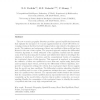Free Online Productivity Tools
i2Speak
i2Symbol
i2OCR
iTex2Img
iWeb2Print
iWeb2Shot
i2Type
iPdf2Split
iPdf2Merge
i2Bopomofo
i2Arabic
i2Style
i2Image
i2PDF
iLatex2Rtf
Sci2ools
100
click to vote
AMC
2007
2007
Existence and computation of short-run equilibria in economic geography
The new economic geography literature provides a general equilibrium framework that explains the emergence of economic agglomerations as a trade-off between increasing returns at the firm level and transportation costs related to the shipment of goods. The existence and uniqueness of short–run equilibria of this model has been shown for the case of two regions. The proposed approach employs the differential evolution algorithm to obtain estimates of the Lipschitz constant and the infinity norm of the function along the boundary and utilizes these values to investigate the existence of solutions of a function, and the computational burden of computing the topological degree of this function. This approach is employed to investigate the existence of short–run equilibria for more than two regions using fixed point and topological degree theory, as well as, the differential evolution algorithm. Irrespective of parameter settings the criteria from topological degree theory sugges...
Related Content
| Added | 24 Dec 2010 |
| Updated | 24 Dec 2010 |
| Type | Journal |
| Year | 2007 |
| Where | AMC |
| Authors | Nicos G. Pavlidis, Michael N. Vrahatis, P. Mossay |
Comments (0)

